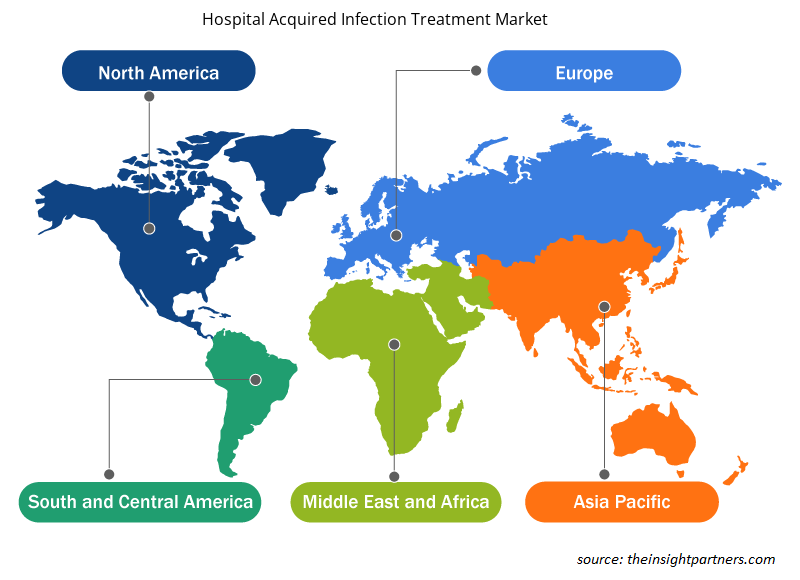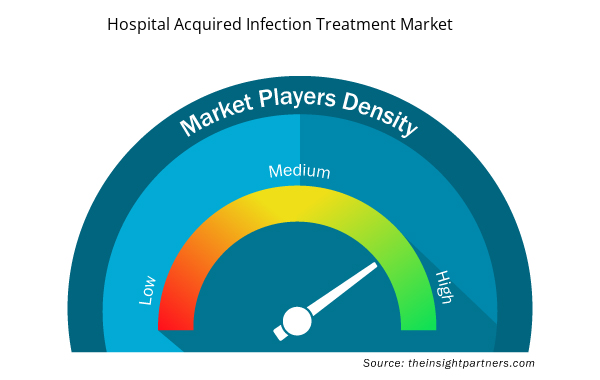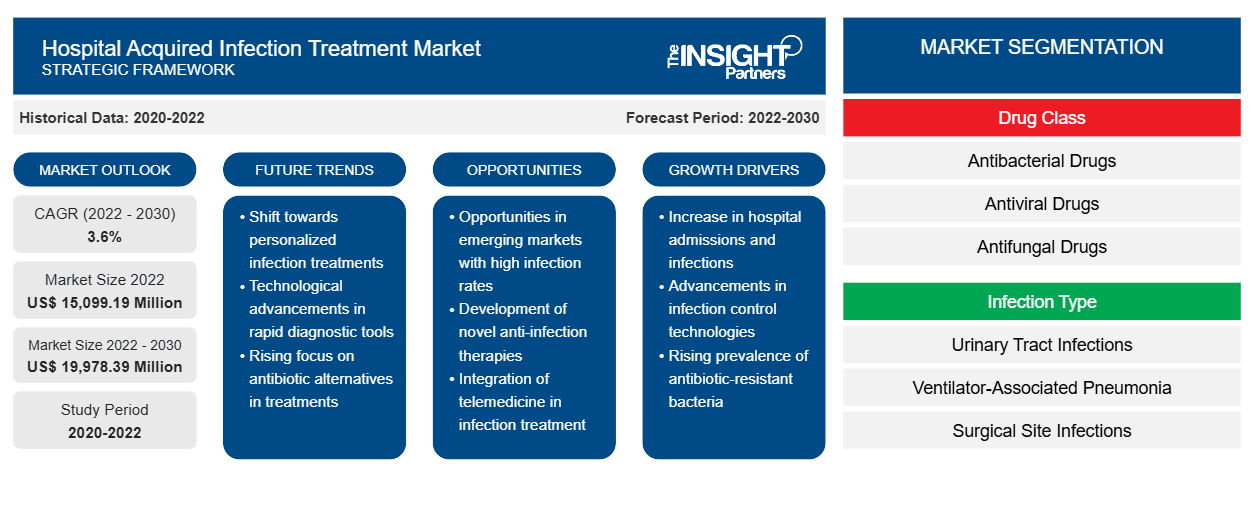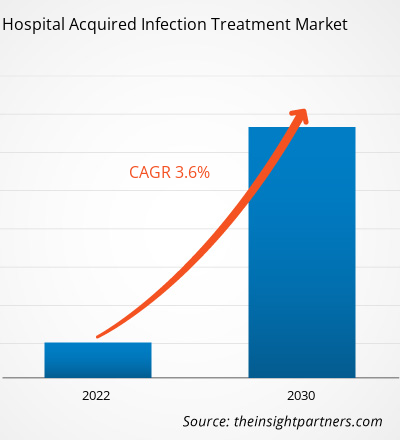[Forschungsbericht] Der Markt für die Behandlung von im Krankenhaus erworbenen Infektionen soll von 15.099,19 Millionen US-Dollar im Jahr 2022 auf 19.978,39 Millionen US-Dollar im Jahr 2030 wachsen; von 2022 bis 2030 wird eine durchschnittliche jährliche Wachstumsrate (CAGR) von 3,6 % erwartet.
Markteinblicke und Analystenansichten:
Im Krankenhaus erworbene Infektionen (HAIs), auch bekannt als nosokomiale Infektionen, können in einer Vielzahl von Umgebungen auftreten, darunter Krankenhäuser, Langzeitpflegeeinrichtungen und ambulante Einrichtungen, und sie können auch nach der Entlassung auftreten. HAIs können auch Berufsinfektionen sein, die das Gesundheitspersonal betreffen. Die wichtigsten Faktoren, die das Wachstum des Marktes für die Behandlung von im Krankenhaus erworbenen Infektionen vorantreiben, sind die hohe Prävalenz von HAIs und der zunehmende Fokus auf Patientensicherheit und qualitativ hochwertige Pflege. Die Bedrohung durch antimikrobielle Resistenz behindert jedoch das Wachstum des Marktes für die Behandlung von im Krankenhaus erworbenen Infektionen .
Wachstumstreiber und -hemmnisse:
Beispiele für im Gesundheitswesen auftretende Infektionen (HAIs) sind zentralvenöse Katheter-assoziierte Blutstrominfektionen, katheterassoziierte Harnwegsinfektionen und beatmungsassoziierte Pneumonie. Diese Infektionen, die als Wundinfektionen bezeichnet werden, können auch an Operationsstellen auftreten. Laut dem 2021 veröffentlichten Bericht „2020 National and State Healthcare-Associated Infections Progress Report“ der Centers for Disease Control and Prevention (CDC) nahmen die Fälle zentralvenöser Katheter-assoziierter Blutstrominfektionen, Methicillin-resistenter Staphylococcus aureus (MRSA)-Bakteriämie und beatmungsassoziierter Ereignisse in den USA zwischen 2019 und 2020 um 24 %, 35 % bzw. 15 % zu.
Darüber hinaus sind Harnwegsinfektionen (HWI) laut dem Bericht des National Healthcare Safety Network (NHSN) vom Januar 2022 die fünfthäufigste Art von im Gesundheitswesen auftretenden Infektionen. HWI machen mehr als 9,5 % der Erkrankungen in Akutkrankenhäusern aus. Katheterassoziierte Harnwegsinfektionen (CAUTI) werden durch Harnkatheter verursacht, die zum Ablassen von Urin aus der Blase verwendet werden. CAUTI ist eine der häufigsten Infektionen bei hospitalisierten Patienten mit HWI. Laut den Centers for Disease Control and Prevention (CDC) stehen fast 75 % der Infektionen mit einem Harnkatheter im Zusammenhang. Während ihres Krankenhausaufenthalts müssen 15 % bis 25 % der hospitalisierten Patienten Harnkatheter verwenden. Die längere Verwendung von Harnkathetern ist der größte Risikofaktor für CAUTI. Komplikationen bei CAUTI führen zu Leiden des Patienten, längeren Krankenhausaufenthalten, erhöhten Behandlungskosten und sogar zum Tod.
Darüber hinaus sind Harnwegsinfektionen laut CDC jedes Jahr für mehr als 13.000 Todesfälle verantwortlich. Eine akute unkomplizierte Blasenentzündung verursacht etwa sechs Tage Beschwerden und führt zu etwa 7 Millionen Arztbesuchen pro Jahr, die Kosten in Höhe von 1,6 Milliarden US-Dollar verursachen. Infolgedessen stellt die steigende Zahl der HAI-Fälle eine erhebliche finanzielle Belastung für das Gesundheitssystem dar. Die zunehmende Verbreitung von CAUTI in Verbindung mit der gestiegenen Nachfrage nach Medikamenten zur Behandlung treibt den Markt an.
Allerdings stellt die antimikrobielle Resistenz eine große Herausforderung für die Behandlung von HAI dar, da sie die Wirksamkeit vorhandener antimikrobieller Mittel begrenzt und die Entwicklung neuer Behandlungsstrategien und antimikrobieller Alternativen erforderlich macht, um resistente Krankheitserreger wirksam zu bekämpfen.
Passen Sie diesen Bericht Ihren Anforderungen an
Sie erhalten kostenlos individuelle Anpassungen an jedem Bericht, einschließlich Teilen dieses Berichts oder einer Analyse auf Länderebene, eines Excel-Datenpakets sowie tolle Angebote und Rabatte für Start-ups und Universitäten.
- Holen Sie sich die wichtigsten Markttrends aus diesem Bericht.Dieses KOSTENLOSE Beispiel umfasst eine Datenanalyse von Markttrends bis hin zu Schätzungen und Prognosen.
Berichtssegmentierung und -umfang:
Der globale Markt für die Behandlung von im Krankenhaus erworbenen Infektionen ist nach Arzneimittelklasse, Infektionstyp und Vertriebskanal segmentiert. Basierend auf der Arzneimittelklasse ist der Markt für die Behandlung von im Krankenhaus erworbenen Infektionen in antibakterielle Medikamente, antivirale Medikamente, antimykotische Medikamente und andere unterteilt. Basierend auf dem Infektionstyp wird die Behandlung von im Krankenhaus erworbenen Infektionen in Harnwegsinfektionen, beatmungsassoziierte Pneumonie, Wundinfektionen, Blutbahninfektionen und andere Krankenhausinfektionen unterschieden. Basierend auf dem Vertriebskanal ist der Markt in Krankenhausapotheken, Einzelhandelsapotheken, E-Commerce und andere segmentiert. Der Markt für die Behandlung von im Krankenhaus erworbenen Infektionen ist geografisch segmentiert in Nordamerika (USA, Kanada und Mexiko), Europa (Deutschland, Frankreich, Italien, Großbritannien, Russland und das übrige Europa), Asien-Pazifik (Australien, China, Japan, Indien, Südkorea und der restliche Asien-Pazifik-Raum), den Nahen Osten und Afrika (Südafrika, Saudi-Arabien, die Vereinigten Arabischen Emirate und der restliche Nahe Osten und Afrika) sowie Süd- und Mittelamerika (Brasilien, Argentinien und der restliche Süd- und Mittelamerika).
Segmentanalyse:
Der Markt für die Behandlung von im Krankenhaus erworbenen Infektionen ist nach Arzneimittelklassen in antibakterielle Arzneimittel, antivirale Arzneimittel, antimykotische Arzneimittel und andere unterteilt. Das Segment der antibakteriellen Arzneimittel hatte 2022 den größten Marktanteil und wird voraussichtlich zwischen 2022 und 2030 die höchste durchschnittliche jährliche Wachstumsrate verzeichnen.
Der Markt für die Behandlung von im Krankenhaus erworbenen Infektionen ist nach Infektionstyp in Harnwegsinfektionen , beatmungsassoziierte Pneumonie, Wundinfektionen, Blutbahninfektionen und andere Krankenhausinfektionen unterteilt. Das Segment Harnwegsinfektionen hatte 2022 den größten Marktanteil. Es wird jedoch erwartet, dass das Segment beatmungsassoziierte Pneumonie von 2022 bis 2030 die höchste durchschnittliche jährliche Wachstumsrate verzeichnet.
Der Markt für die Behandlung von im Krankenhaus erworbenen Infektionen ist nach Vertriebskanälen in Krankenhausapotheken, Einzelhandelsapotheken, E-Commerce und andere unterteilt. Im Jahr 2022 hatte das Segment der Krankenhausapotheken den größten Marktanteil, und es wird erwartet, dass dasselbe Segment zwischen 2022 und 2030 die höchste durchschnittliche jährliche Wachstumsrate verzeichnet.
Regionale Analyse:
Geografisch ist der globale Markt für die Behandlung von Krankenhausinfektionen in fünf Hauptregionen unterteilt: Nordamerika, Europa, Asien-Pazifik, Süd- und Mittelamerika sowie Naher Osten und Afrika.
Im Jahr 2022 hatte Nordamerika den größten Anteil am weltweiten Markt für die Behandlung von im Krankenhaus erworbenen Infektionen. In den USA gibt es eine hohe Prävalenz von HAI, was das Wachstum des Marktes für die Behandlung von im Krankenhaus erworbenen Infektionen vorantreibt. Laut CDC hat an jedem beliebigen Tag etwa 1 von 31 Krankenhauspatienten mindestens eine HAI. Ebenso können HAIs und andere Infektionen laut dem Office of Disease Prevention and Health Promotion zu Sepsis führen und verursachen in den USA jährlich etwa 1,7 Millionen Krankheitsfälle und 270.000 Todesfälle. Somit treibt die hohe Prävalenz von HAI unter den Menschen in den USA das Wachstum des Marktes für die Behandlung von im Krankenhaus erworbenen Infektionen an.
Branchenentwicklungen und zukünftige Chancen:
Nachfolgend sind verschiedene Initiativen wichtiger Akteure auf dem globalen Markt für die Behandlung von im Krankenhaus erworbenen Infektionen aufgeführt:
- Im Mai 2023 gab Innoviva Specialty Therapeutics bekannt, dass die US-amerikanische Food and Drug Administration (FDA) XACDURO (Sulbactam zur Injektion; Durlobactam zur Injektion) zugelassen hat, das für die intravenöse Anwendung bei Patienten ab 18 Jahren zur Behandlung von im Krankenhaus erworbener bakterieller Pneumonie und beatmungsassoziierter bakterieller Pneumonie (HABP/VABP) zugelassen ist, die durch anfällige Isolate des Acinetobacter baumannii-calcoaceticus-Komplexes (Acinetobacter) verursacht wird. Innoviva Specialty Therapeutics gab an, dass es sich auf die Bereitstellung innovativer Therapien in der Intensivpflege und bei Infektionskrankheiten konzentriert.
- Im Mai 2023 gaben Forscher des Indian Institute of Science Education and Research (IISER), Pune und des Central Drug Research Institute (CSIR-CDRI), Lucknow bekannt, dass sie ein potenzielles neues Antibiotikum gegen Acinetobacter baumannii entdeckt hätten, das häufig HAIs verursacht.
- Im September 2020 gab Shionogi & Co Ltd bekannt, dass die FDA einen ergänzenden Antrag auf Zulassung eines neuen Arzneimittels (sNDA) für FETROJA (Cefiderocol) zur Behandlung von Patienten ab 18 Jahren mit im Krankenhaus erworbener bakterieller Lungenentzündung und beatmungsassoziierter bakterieller Lungenentzündung (HABP/VABP) genehmigt habe, die durch anfällige gramnegative Mikroorganismen wie Enterobacter cloacae-Komplex, Klebsiella pneumoniae, Acinetobacter baumannii-Komplex, Escherichia coli, Pseudomonas aeruginosa und Serratia marcescens verursacht werde.
- Im Juni 2020 gab Merck bekannt, dass die US-amerikanische Food and Drug Administration (FDA) einen ergänzenden Zulassungsantrag (sNDA) für RECARBRIO (Imipenem, Cilastatin und Relebactam) zur Behandlung von Patienten ab 18 Jahren genehmigt hat, die an im Krankenhaus erworbener bakterieller Pneumonie und beatmungsassoziierter bakterieller Pneumonie (HABP/VABP) leiden, die durch anfällige gramnegative Mikroorganismen wie Acinetobacter calcoaceticus-baumannii-Komplex, Klebsiella oxytoca, Klebsiella pneumoniae, Enterobacter cloacae, Escherichia coli, Haemophilus influenzae, Klebsiella aerogenes, Pseudomonas aeruginosa und Serratia marcescens verursacht werden.
Regionale Einblicke in den Markt für die Behandlung von im Krankenhaus erworbenen Infektionen
Die regionalen Trends und Faktoren, die den Markt für die Behandlung von im Krankenhaus erworbenen Infektionen während des gesamten Prognosezeitraums beeinflussen, wurden von den Analysten von Insight Partners ausführlich erläutert. In diesem Abschnitt werden auch die Marktsegmente und die Geografie für die Behandlung von im Krankenhaus erworbenen Infektionen in Nordamerika, Europa, im asiatisch-pazifischen Raum, im Nahen Osten und Afrika sowie in Süd- und Mittelamerika erörtert.

- Erhalten Sie regionale Daten zum Markt für die Behandlung von im Krankenhaus erworbenen Infektionen
Umfang des Marktberichts zur Behandlung von im Krankenhaus erworbenen Infektionen
| Berichtsattribut | Details |
|---|---|
| Marktgröße im Jahr 2022 | 15.099,19 Millionen US-Dollar |
| Marktgröße bis 2030 | 19.978,39 Millionen US-Dollar |
| Globale CAGR (2022 - 2030) | 3,6 % |
| Historische Daten | 2020-2022 |
| Prognosezeitraum | 2022–2030 |
| Abgedeckte Segmente | Nach Arzneimittelklasse
|
| Abgedeckte Regionen und Länder | Nordamerika
|
| Marktführer und wichtige Unternehmensprofile |
|
Marktteilnehmerdichte für die Behandlung von Krankenhausinfektionen: Auswirkungen auf die Geschäftsdynamik verstehen
Der Markt für die Behandlung von Krankenhausinfektionen wächst rasant. Dies wird durch die steigende Nachfrage der Endnutzer aufgrund von Faktoren wie sich entwickelnden Verbraucherpräferenzen, technologischen Fortschritten und einem größeren Bewusstsein für die Vorteile des Produkts vorangetrieben. Mit der steigenden Nachfrage erweitern Unternehmen ihr Angebot, entwickeln Innovationen, um die Bedürfnisse der Verbraucher zu erfüllen, und nutzen neue Trends, was das Marktwachstum weiter ankurbelt.
Die Marktteilnehmerdichte bezieht sich auf die Verteilung von Firmen oder Unternehmen, die in einem bestimmten Markt oder einer bestimmten Branche tätig sind. Sie gibt an, wie viele Wettbewerber (Marktteilnehmer) in einem bestimmten Marktraum im Verhältnis zu seiner Größe oder seinem gesamten Marktwert präsent sind.
Die wichtigsten Unternehmen, die auf dem Markt für die Behandlung von im Krankenhaus erworbenen Infektionen tätig sind, sind:
- Merck & Co Inc
- Pfizer Inc
- AbbVie Inc
- Paratek Pharmaceuticals Inc
- Eugia US LLC
Haftungsausschluss : Die oben aufgeführten Unternehmen sind nicht in einer bestimmten Reihenfolge aufgeführt.

- Überblick über die wichtigsten Akteure auf dem Markt für die Behandlung von Krankenhausinfektionen
Wettbewerbslandschaft und Schlüsselunternehmen:
Merck & Co Inc, Pfizer Inc, AbbVie Inc, Paratek Pharmaceuticals Inc, Eugia US LLC, Abbott Laboratories, Cumberland Pharmaceuticals Inc, Innoviva Specialty Therapeutics Inc, Cipla Ltd und Eli Lilly and Company gehören zu den führenden Akteuren auf dem Markt für die Behandlung von im Krankenhaus erworbenen Infektionen. Diese Unternehmen konzentrieren sich auf neue Technologien, die Weiterentwicklung bestehender Produkte und die geografische Expansion, um die weltweit wachsende Verbrauchernachfrage zu erfüllen und ihr Produktangebot in Spezialportfolios zu erweitern.
- Historische Analyse (2 Jahre), Basisjahr, Prognose (7 Jahre) mit CAGR
- PEST- und SWOT-Analyse
- Marktgröße Wert/Volumen – Global, Regional, Land
- Branche und Wettbewerbsumfeld
- Excel-Datensatz


- Analog-to-Digital Converter Market
- Foot Orthotic Insoles Market
- Sleep Apnea Diagnostics Market
- Authentication and Brand Protection Market
- Electronic Shelf Label Market
- Bathroom Vanities Market
- Antibiotics Market
- Quantitative Structure-Activity Relationship (QSAR) Market
- Hair Wig Market
- Electronic Health Record Market

Report Coverage
Revenue forecast, Company Analysis, Industry landscape, Growth factors, and Trends

Segment Covered
This text is related
to segments covered.

Regional Scope
North America, Europe, Asia Pacific, Middle East & Africa, South & Central America

Country Scope
This text is related
to country scope.
Häufig gestellte Fragen
Hospital-acquired infections (HAI), also known as nosocomially acquired infections. HAIs are infections acquired during medical treatment that were not present at the time of admission. They may develop in a variety of settings, including hospitals, long-term care institutions, and ambulatory settings, and they can also appear after discharge. HAIs can also involve occupational infections that affect healthcare workers.
The hospital acquired infection treatment market majorly consists of the players, including Merck & Co Inc, Pfizer Inc, AbbVie Inc, Paratek Pharmaceuticals Inc, Eugia US LLC, Abbott Laboratories, Cumberland Pharmaceuticals Inc, Innoviva Specialty Therapeutics Inc, Cipla Ltd, and Eli Lilly and Company.
Key factors driving the hospital acquired infection treatment market growth include the high prevalence of hospital-acquired infections (HAI) and the growing focus on patient safety and quality care.
The hospital acquired infection treatment market was valued at US$ 15,099.19 million in 2022.
The hospital acquired infection treatment market, by distribution channel, is segmented into hospital pharmacies, retail pharmacies, e-commerce, and others. In 2022, the hospitals pharmacies segment held the largest market share, and the same segment is anticipated to register the highest CAGR during 2022–2030.
The hospital acquired infection treatment market is expected to be valued at US$ 19,978.39 million in 2030.
The hospital acquired infection treatment market, by infection type, is segmented into urinary tract infections, ventilator-associated pneumonia, surgical site infections, bloodstream infections, and other hospital infections. The urinary tract infections segment held a larger market share in 2022; However, the ventilator-associated pneumonia segment is anticipated to register a higher CAGR during 2022-2030.
The hospital acquired infection treatment market, by drug class, is segmented into antibacterial drugs, antiviral drugs, antifungal drugs, and others. The antibacterial drugs segment held a larger market share in 2022, and the same segment is anticipated to register a higher CAGR during 2022-2030.
Trends and growth analysis reports related to Life Sciences : READ MORE..
The List of Companies - Hospital Acquired Infection Treatment Market
- Merck & Co Inc
- Pfizer Inc
- AbbVie Inc
- Paratek Pharmaceuticals Inc
- Eugia US LLC
- Abbott Laboratories
- Cumberland Pharmaceuticals Inc
- Innoviva Specialty Therapeutics Inc
- Cipla Ltd
- Eli Lilly and Company
The Insight Partners performs research in 4 major stages: Data Collection & Secondary Research, Primary Research, Data Analysis and Data Triangulation & Final Review.
- Data Collection and Secondary Research:
As a market research and consulting firm operating from a decade, we have published and advised several client across the globe. First step for any study will start with an assessment of currently available data and insights from existing reports. Further, historical and current market information is collected from Investor Presentations, Annual Reports, SEC Filings, etc., and other information related to company’s performance and market positioning are gathered from Paid Databases (Factiva, Hoovers, and Reuters) and various other publications available in public domain.
Several associations trade associates, technical forums, institutes, societies and organization are accessed to gain technical as well as market related insights through their publications such as research papers, blogs and press releases related to the studies are referred to get cues about the market. Further, white papers, journals, magazines, and other news articles published in last 3 years are scrutinized and analyzed to understand the current market trends.
- Primary Research:
The primarily interview analysis comprise of data obtained from industry participants interview and answers to survey questions gathered by in-house primary team.
For primary research, interviews are conducted with industry experts/CEOs/Marketing Managers/VPs/Subject Matter Experts from both demand and supply side to get a 360-degree view of the market. The primary team conducts several interviews based on the complexity of the markets to understand the various market trends and dynamics which makes research more credible and precise.
A typical research interview fulfils the following functions:
- Provides first-hand information on the market size, market trends, growth trends, competitive landscape, and outlook
- Validates and strengthens in-house secondary research findings
- Develops the analysis team’s expertise and market understanding
Primary research involves email interactions and telephone interviews for each market, category, segment, and sub-segment across geographies. The participants who typically take part in such a process include, but are not limited to:
- Industry participants: VPs, business development managers, market intelligence managers and national sales managers
- Outside experts: Valuation experts, research analysts and key opinion leaders specializing in the electronics and semiconductor industry.
Below is the breakup of our primary respondents by company, designation, and region:

Once we receive the confirmation from primary research sources or primary respondents, we finalize the base year market estimation and forecast the data as per the macroeconomic and microeconomic factors assessed during data collection.
- Data Analysis:
Once data is validated through both secondary as well as primary respondents, we finalize the market estimations by hypothesis formulation and factor analysis at regional and country level.
- Macro-Economic Factor Analysis:
We analyse macroeconomic indicators such the gross domestic product (GDP), increase in the demand for goods and services across industries, technological advancement, regional economic growth, governmental policies, the influence of COVID-19, PEST analysis, and other aspects. This analysis aids in setting benchmarks for various nations/regions and approximating market splits. Additionally, the general trend of the aforementioned components aid in determining the market's development possibilities.
- Country Level Data:
Various factors that are especially aligned to the country are taken into account to determine the market size for a certain area and country, including the presence of vendors, such as headquarters and offices, the country's GDP, demand patterns, and industry growth. To comprehend the market dynamics for the nation, a number of growth variables, inhibitors, application areas, and current market trends are researched. The aforementioned elements aid in determining the country's overall market's growth potential.
- Company Profile:
The “Table of Contents” is formulated by listing and analyzing more than 25 - 30 companies operating in the market ecosystem across geographies. However, we profile only 10 companies as a standard practice in our syndicate reports. These 10 companies comprise leading, emerging, and regional players. Nonetheless, our analysis is not restricted to the 10 listed companies, we also analyze other companies present in the market to develop a holistic view and understand the prevailing trends. The “Company Profiles” section in the report covers key facts, business description, products & services, financial information, SWOT analysis, and key developments. The financial information presented is extracted from the annual reports and official documents of the publicly listed companies. Upon collecting the information for the sections of respective companies, we verify them via various primary sources and then compile the data in respective company profiles. The company level information helps us in deriving the base number as well as in forecasting the market size.
- Developing Base Number:
Aggregation of sales statistics (2020-2022) and macro-economic factor, and other secondary and primary research insights are utilized to arrive at base number and related market shares for 2022. The data gaps are identified in this step and relevant market data is analyzed, collected from paid primary interviews or databases. On finalizing the base year market size, forecasts are developed on the basis of macro-economic, industry and market growth factors and company level analysis.
- Data Triangulation and Final Review:
The market findings and base year market size calculations are validated from supply as well as demand side. Demand side validations are based on macro-economic factor analysis and benchmarks for respective regions and countries. In case of supply side validations, revenues of major companies are estimated (in case not available) based on industry benchmark, approximate number of employees, product portfolio, and primary interviews revenues are gathered. Further revenue from target product/service segment is assessed to avoid overshooting of market statistics. In case of heavy deviations between supply and demand side values, all thes steps are repeated to achieve synchronization.
We follow an iterative model, wherein we share our research findings with Subject Matter Experts (SME’s) and Key Opinion Leaders (KOLs) until consensus view of the market is not formulated – this model negates any drastic deviation in the opinions of experts. Only validated and universally acceptable research findings are quoted in our reports.
We have important check points that we use to validate our research findings – which we call – data triangulation, where we validate the information, we generate from secondary sources with primary interviews and then we re-validate with our internal data bases and Subject matter experts. This comprehensive model enables us to deliver high quality, reliable data in shortest possible time.


 Holen Sie sich ein kostenloses Muster für diesen Bericht
Holen Sie sich ein kostenloses Muster für diesen Bericht